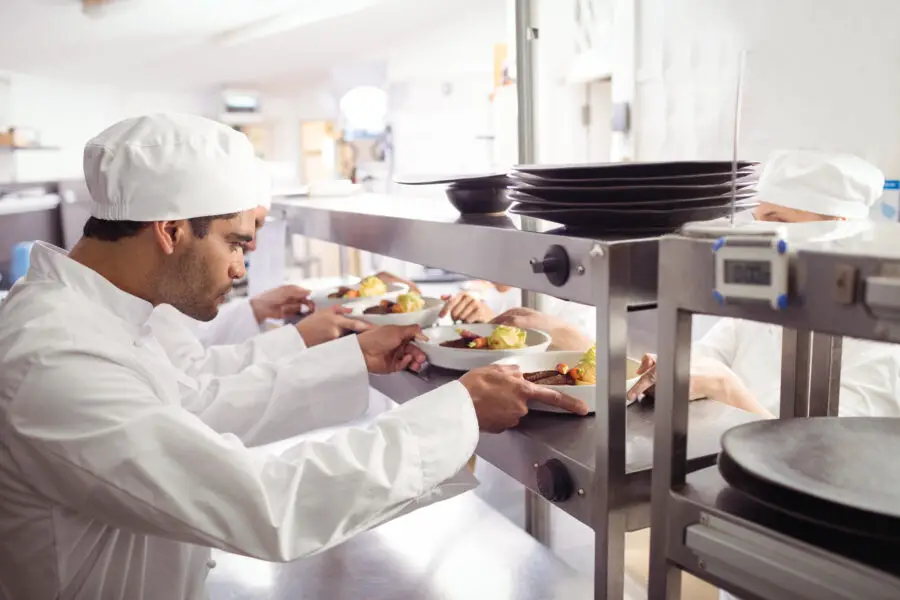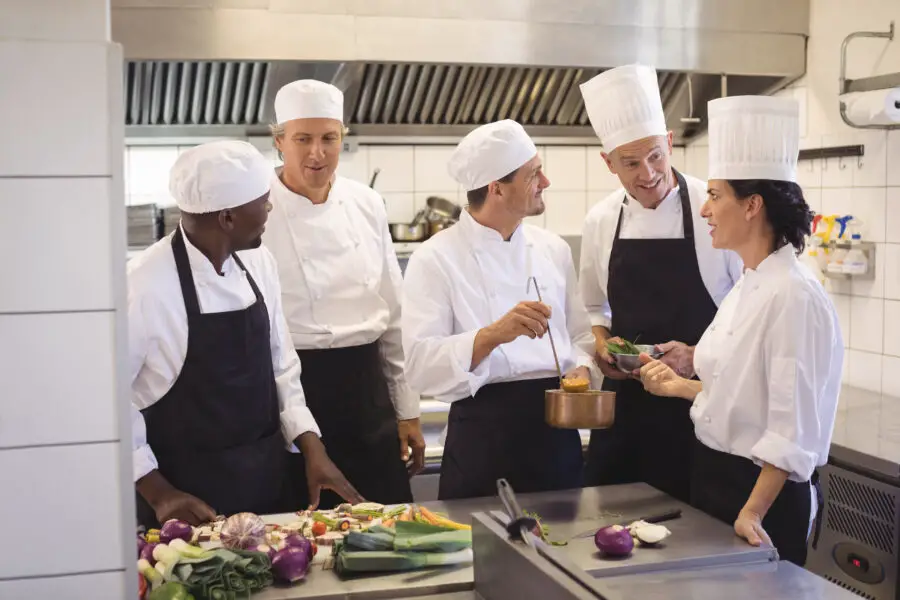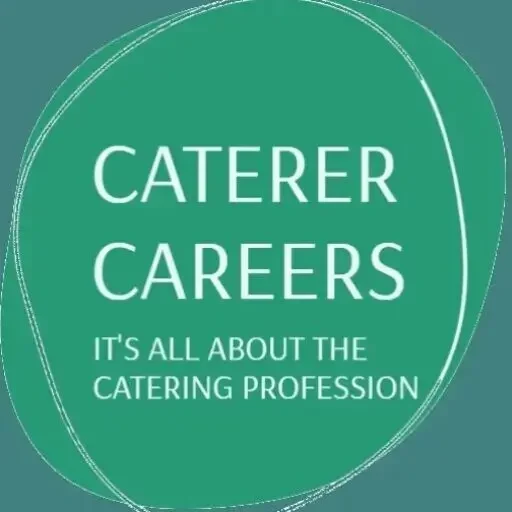
A workplace environment involves lots of activities, and getting a job done is always inevitable.
At the peak of operations, you can imagine the incessant communications between chefs.
Objects are moved from one place to another, things are lifted from one position to another.
The urge to get things done keeps looming!
Instructions are given, and instructions are followed.
Items are passed from one hand to another.
The work environment can sometimes be like a marketplace.
The activities we see at a construction site portray a work environment–and could relate to any other workplace.
Jobs carried out in a safe practice manner can guarantee the safety of the worker.
Working in the kitchen also involves lifting objects. In fact, your employer will inform you, descriptively, that your duties will involve lifting objects.
If you want to carry an object of about 5 KG, you’ll put something into consideration — “the weight”.
As a result of that, you’ll be cautious about how you lift the object.
So, if we want to do a job, we should bear in mind that it has to be done in a safe manner so we can stay injury-free.
Work activities that negate safe practices could attract hazards.
“Safety is no accident”!
If an oven is in the kitchen, oven gloves should be provided as well.
The oven gloves are designed so that the usage of them will help to avoid burns or injury.
The ultimate reason for safe practices is to enable us to avoid injuries at any place of work.
When someone carries something on his/her shoulder and wants to drop the object on the ground, the individual doesn’t drop the object anyhow, he/she takes care to drop the item on the ground.
Have you ever seen a crane lift an object?
Have you ever seen a forklift pick up an object?
The crane lifts an object from one position and drops it at another location carefully.
A forklift picks up an item from one location, takes it to another position, and drops the object in a careful manner.
No matter the industry we may be in, work-safe practices are universal.
The fact remains that we’ll always come in contact with objects in any workplace environment.
1. ELECTRICAL APPLIANCES
These technologies have facilitated our tasks in the kitchen.
I’ve wondered what we would have done without them!
The modern-day chef has many electrical gadgets he/she can rely on for their day-to-day job.
A microwave can steam water, cook potatoes, roast a chicken, etc.
A salamander can glaze a food item to a lovely brown or golden color.
How about an oven that assists us in our baking activities?
Do you remember the lovely pancakes we cook on a flat-top grill or non-stick pan?
The inception of impingers is a marvel! Food ingredients journey from one end to another end, and are cooked.
The freezers and refrigerators provide us excellent services by keeping food products chilled, and also making food items stay in frozen conditions.
I may not mention other electrical appliances, gadgets, or equipment, but I needed to say, a few, just to make my points.
On the other hand, this equipment, we work with, can be hazardous if they’re not put to use correctly, or if we relate with them inappropriately.
If they are not maintained to the best hygienic standards, they could contaminate the procession of food.
So, it’s important that equipment is maintained on a regular basis.
2. PERSONAL PROTECTIVE EQUIPMENT
Personal safety at the workplace is so important!
When there’s no provision for personal protective equipment (PPE) at a workplace, it’s like a workman without his tools.
Why do we need personal protective equipment?
Do they really assist us in kitchen operations?
The chef’s kit: hat, jacket, eye goggles, trousers, and shoes, do give some sort of protection for our body.
So, it’s essential that caterers should utilize personal protective equipment anytime he/she is on duty in the kitchen.
3. SPILLAGES
Spillages are something that can occur whenever chefs are on active duty.
Follow these procedures to avoid spillage occurrences:
- When you are cooking something in the microwave that contains liquid, ensure you use a napkin to hold and remove it.
- If you are lifting the fryer basket, containing food items from the deep fryer, ensure you don’t lift it with force, to avoid splash of hot oil on your body. After the completion of the day’s job. Turn off the deep fat fryer, and allow the hot oil within to cool down before draining and cleaning.
- If you have something on the burner/stove cooking with liquid content, before you carry out the pot, ensure it is no longer at boiling point, and put it in a safe area for it to cool down.
- avoid water or oil spillages on the floor — this could cause slip-and-fall hazards.
Follow these procedures when spillages occur in the kitchen:
- When there is a spillage of water on the floor, get a mop and clean it up immediately.
- If it happens that oil is poured on the floor, the cleanup can take some time, due to the greasy nature of oil. Soap and water should be applied when scrubbing the floor to achieve thorough cleaning.
- if hot liquid splashes on your hand, seek first aid immediately.

chefs on duty in the kitchen.
4. EQUIPMENT ARRANGEMENT IN THE KITCHEN
The way equipment is positioned in the kitchen will determine how easily one can move around within the kitchen.
So, kitchen equipment should be arranged properly to allow for easy movements in the work area.
Objects should not be allowed to stay on walkways to avoid trip-and-fall hazards.
In any case, if an object is needed to carry out a task within the operations area, that object should be removed from the access ways immediately after the task is done.
5. REPORT FAULTY EQUIPMENT
As a chef, you must understand that your duty is not always only about cooking, there are other issues you must attend to.
In an establishment where split shifts are done, you must understand that any duty shift you’re in, whether morning, afternoon, or night, you must take care of issues.
If you’re on a morning shift, as you resume, take a few minutes to examine the equipment you are going to work with, and if they are in good condition before you operate or put it to use.
When you are on afternoon or night shift duty, the same procedures should be carried out.
For instance, check that the chillers and freezers are in good operational condition. Check that their temperature level is accurate in order to preserve materials that are stored in them.
A refrigerator should be at 5° Celsius while the freezer should be at -18° Celsius.
When you notice any malfunctioning or faulty equipment, report the incident to the senior chef on duty.
When machines are not in good condition, they’ll become hazardous in the workplace.
Chefs should bear in mind that workers stay injury-free when they observe safe work practices.
NOTE: Caterers should be aware of where a first aid box is situated in the kitchen, they should be trained on how to administer first aid in case of injury.
They must know the position of a fire blanket in the kitchen. Cooks have to be educated on the use of a fire blanket in case of emergency.
The kitchen staff has to be informed where a fire alarm switch or button can be found in the workplace in case of emergency.
Chemicals used for cleaning can be hazardous, and kitchen staff must understand their usage or application.
Tools like mandolin, meat slicer, or meat mincer can cause injury to the hand or finger if not used with care.
Chefs must know the position of a fire extinguisher in the kitchen, they have to be knowledgeable on how the extinguisher is discharged in case of a fire outbreak.
A mustering point has to be communicated to staff should it happen there be an emergency that requires workers to evacuate the building

